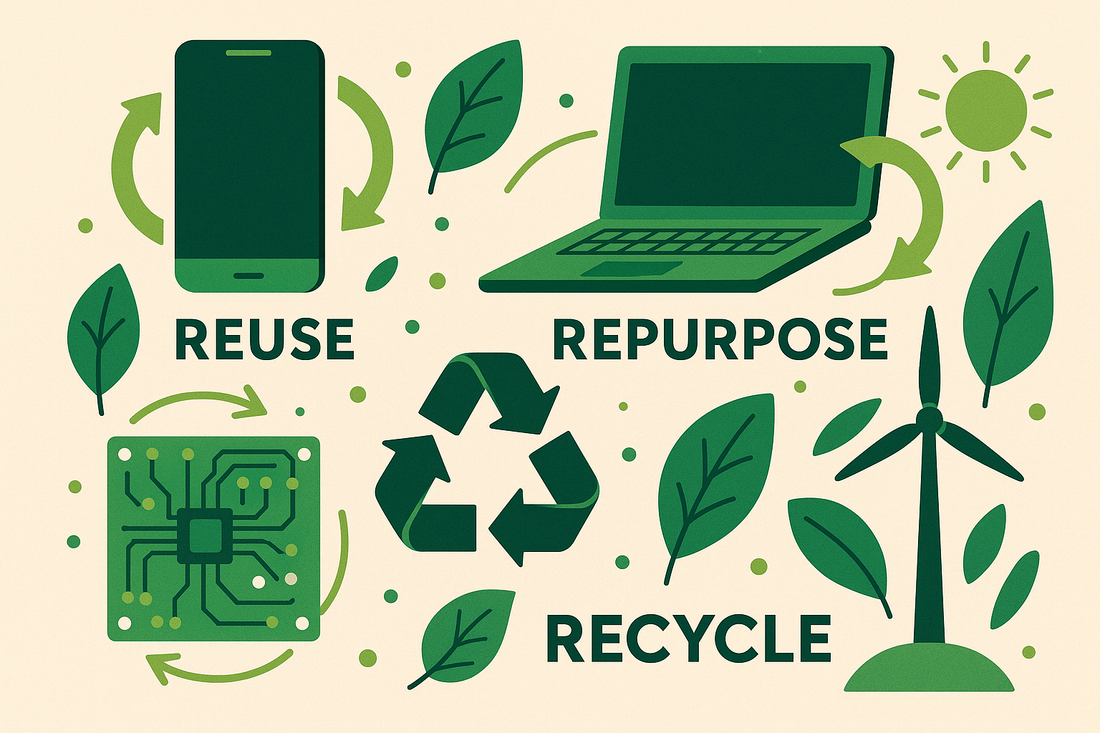Moving beyond the familiar concept of the three R's (Reduce, Reuse, Recycle), the comprehensive framework known as the 5 R's is key to minimizing our environmental footprint and steering toward a zero-waste future.
Refuse, Reduce, Reuse, Repurpose, Recycle: These five principles empower individuals and organizations to make conscious choices that benefit our shared present and future.
Beyond Reduce, Reuse, Recycle: The Benefits Of The 5 R's For Society & The Environment
The old-school slogan ‘Reduce, Reuse, Recycle’ was popularized in the 1970s, when our consumerist economy was in full swing.
Today, the 5 R's take the concept a step further, guiding us toward mindful consumption and a culture of care that supports our communities and the planet in many ways.
Environmental Preservation And Resource Conservation
Opting to refuse and reduce new products helps lower pollution and ease the greenhouse gas emissions tied to the manufacturing and disposal of goods.
Similarly, by weaving the idea of ‘reuse, recycle’ into supply chains and daily habits, materials get a longer life cycle — a key move to help save natural resources, which are running out faster than ever.
Take electronics, for example: Electronic devices depend on rare minerals such as gold, silver, copper, and palladium. To build just one computer and monitor, it takes about 500 pounds of fossil fuel, 50 pounds of chemicals, and 1.5 tons of water.
The 5 Rs help ease this strain, keeping valuable resources in use instead of being wasted.
Economic Advantages
5R equals substantial cost savings for families and businesses alike.
Household Budget
It’s simple math: when you buy less, reuse goods, or purchase refurbished products (like refurbished phones, for example), you end up spending less.
Business Gains
Repurposing assets like old PCs helps companies cut costs, while brands that run Extended Producer Responsibility (EPR) initiatives build trust and credibility with eco-minded customers.
E-Waste Management
Recovered materials carry real value, too. For instance, e-waste holds around 10,000g of gold per ton—far more than the 0.5–13.5g per ton found in gold ore.
Mitigating The Global Waste Crisis
Waste keeps piling up. The mountain of discarded electronics alone hit a record 62 million tonnes of e-waste a couple of years ago.
Picture it: 1.55 million 40-tonne trucks packed with old laptops, smartphones, hard drives, cables, and monitors — enough to form a bumper-to-bumper convoy around the entire equator!
Yet, only 22.3% of it was officially documented as properly collected and recycled.
In monetary terms, that’s US$62 billion worth of recoverable natural resources unaccounted for - on top of the environmental and health risks, and the added costs, borne by communities worldwide.
At its heart, the 5R waste management keeps materials in use and out of landfills, easing the load on waste systems and protecting public health.
How to Apply The 5 R's (Steps)
The 5R principle follows a sustainable and cost-effective hierarchy: the priority here is to prevent waste before it even appears, with recycling seen as the last option when none of the previous steps can apply.
STEP ONE: Refuse
The strongest way to cut waste is to say ‘no’ from the start, and keep products and materials that are not really needed out of your home or workplace before they even arrive.
For businesses, sustainable practices could also mean asking suppliers to avoid excess packaging or use reusable containers.
For individuals, it could be as simple as not purchasing ‘unnecessary’ products or even turning down single-use plastics like straws or plastic bags.
Choosing brands that prioritize durability and repairability, or those with modular designs and easily replaceable parts, also falls under this first ‘R’.
In any case, it helps to pause and ask: “Why are we buying this?”, “Do we really need it?”, “How long is it going to last?”
STEP TWO: Reduce
The next move is to create less waste from what cannot be refused.
It’s about more than just watching what you consume. It also means caring for products to make them last longer - e.g., regular maintenance and cleaning for electronics - opting for energy-efficient devices, or buying in bulk to cut down on packaging.
Every decision that draws less on resources helps shrink your footprint.
STEP THREE: Reuse
Reuse, meaning extending the lifespan of an item for its primary purpose - instead of tossing it without a second thought - is a core aspect of the ‘reuse reduce recycle’ triad.
Think refillable water bottles, durable totes, B2B pallet pooling, item donation… There are all kinds of things you can do to give things a longer life.
For Example, Reusing Electronic Devices Can Mean:
Repair Before Replacing - by applying simple fixes, such as adding memory or updating firmware.
Donate/Sell A Working Device that you no longer use: offer it to a friend, a non-profit, a shelter, or the local school.
No takers nearby?
Circular logistics specialists, like Green Wave Electronics, accept any old electronic devices and components and channel them for repair and IT remarketing, or for responsible recycling when recovery is no longer possible.
Use Trade-In Programs offered by numerous brands - such as trade-in or buy-back options that give you cash back or discounts on future purchases.
Purchase Open Box Items certified for quality by reputable providers. These are widely offered for returned appliances and electronics that have been thoroughly tested and reboxed. Open-box products support the circular economy by giving nearly new, and often unused, items a second life.
STEP FOUR: Repurpose
Repurposing, as well as upcycling, are growing trends where creativity truly shines.
The reasoning behind it is simple: when an item can’t serve its first role, it can take on a new one.
Examples of repurposing can be as simple as using old shirts for cleaning cloths or choosing items with multi-purpose packaging that outlives the product itself - instead of single-use wrappings.
When it comes to electronics, certified refurbishment services reintroduce unwanted phones to the market, offering options for consumers seeking newer models at lower prices or an affordable phone in good condition.
Within business operations, organizations can arrange for old office electronics to be collected for reuse instead of simply discarding them.
Once at the processing facility, devices that cannot be repaired are disassembled. All usable components are then tested and retained to support service calls or legacy systems, thus reducing the need for brand-new replacements.
STEP FIVE: Recycle
Recycling comes last, after the refuse, reduce, reuse, and repurpose part. It encompasses sorting and processing paper, glass, plastic, and metals so they can come back as materials ready for use.
As for electronics, e-waste recycling is vital for sustainable supply chains as it recovers valuable materials and limits the need for raw extraction from nature.
For instance, recycling one million cell phones can recover 35 thousand pounds of copper, 772 pounds of silver, 75 pounds of gold, and 33 pounds of palladium.
Why Is Recycling the Last Option?
From the 5 R's perspective, there are four clear reasons why recycling is the least desirable:
1. Prioritizing Prevention And Extension
The 5 R's begin with prevention. When you refuse what you don’t need and reduce what you use, you avoid waste at its source - a more powerful approach than processing waste after it is created.
2. Energy Consumption
Recycling can be energy-intensive, as sorting, breaking down, and reshaping materials require significant effort and means, even if it helps conserve natural resources.
3. Material Limitations And Degradation
Some materials face limited recyclability or degradation. After multiple recycling cycles, their quality drops. Thus, they cannot remain in the loop indefinitely. This is why recycling is considered only when none of the first four R's can be an option.
4. Preserving Value
When you reuse or repair, you preserve more than just parts. You essentially maintain the original function and value of a product - a more resource-efficient approach than breaking it down into raw material components.
Expanding The R's For Sustainable Supply Chains
At Green Wave Electronics, we expand upon the typical ‘R’ model through sophisticated solutions that encompass all 9 R's of modern reverse logistics:
-
Repair
-
Refurbishment
-
Repackaging
-
Returns Management
-
Replacement
-
Remarketing
-
Redistribution
-
Redeployment
-
Recycling
Rooted in sustainability, our goal is to turn returned, failed, or unwanted products back into valuable assets - through every avenue available.
We skip refusal. At Green Wave Electronics everything finds a home.
We understand that traditional waste management relies on the hierarchy of ‘refuse reduce reuse recycle’, but because we deal with electronics, where products can almost always be given a second life - we skip refusal: At Green Wave Electronics everything finds a home.
If it plugs in or runs on a battery, it finds a place within our comprehensive logistical programs designed for consumer electronics.
Working towards a zero-landfill approach, we focus on maximizing reuse and recovering value in cost-effective and innovative ways.
Ready to turn e-waste into opportunity with smarter recovery and sustainability solutions? Contact us today!



